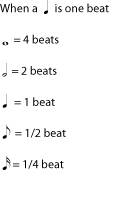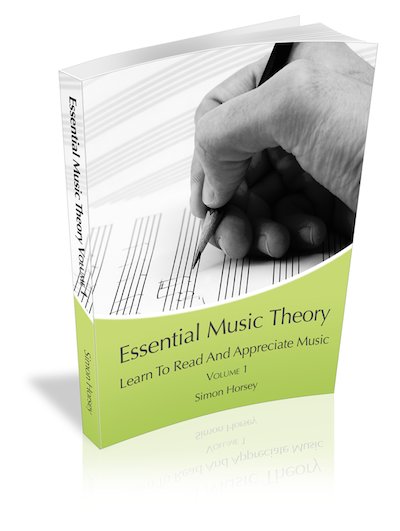The Rhythm Tree
The Rhythm Tree is very important when learning about music. As
you can see from the diagram below it shows you how notes are related.
Understanding how it works is the key to understanding time signatures
and note values. Here is a version of the rhythm tree from the whole
note (semibreve) to the sixteenth note (semiquaver). As you can see, the
notes divide 2:1, i.e., each note divides into 2 notes, both of which
are half the value of the original note. The US note names are on the
left and the UK note names are on the right.
The Rhythm Tree Diagram
If you are just beginning in music you probably use the quarter note
(crotchet) as a basis for note durations and have been taught that this
is worth 1 beat. This is certainly true in a time signature with a 4 on
the bottom. From the rhythm tree you can easily see how there are 2
quarter notes in half note (2 crotchets in a minim) and 4 quarter notes
in a whole note (4 crotchets in a semibreve). You can also see that the
quarter note is divided into 2 eighth notes (a crotchet is divided into 2
quavers) making each eighth note (quaver) worth half of a quarter note (each quaver is half of a crotchet), therefore we can say the duration
of a Whole note (semibreve) is 4 quarter notes, the duration of a Half
note (minim) is 2 quarter notes and the duration of an Eighth note
(quaver) is 1/2 of a quarter note (crotchet).
When a quarter note (crotchet) is given duration one beat the durations of the other notes in the tree are as follows
It is very important to understand the relationship between the notes
as you are not tied to having a quarter note (crotchet) being worth one
beat all the time. In fact, once you understand the rhythm tree, it
doesn't matter which note you consider to be worth one beat because you
understand the relationship between the notes. This is very useful when
you start playing in time signatures other than 2/4, 3/4 and 4/4 where
the quarter note (crotchet) is worth one beat.
**Please
be aware there is no slash between time signatures when they are
written on a music stave, but until there is an html code to display
them easily we have to use one to separate the numbers online!**
Counting
The example above gives the note values when a quarter note (crotchet)
has a duration of 1 beat. Here is another example when the eighth note
(quaver) is given duration 1 beat
UK or US Note names?
Having grown up and learned music in UK it took me a long time to appreciate (and accept!) that the US system is much easier to understand when it comes to learning about time signatures (link to more info coming soon!)... although, as with anything, a knowledge of both is always beneficial, plus it's much more fun to say hemidemisemiquaver than Sixty-fourth note!
One other note, the so-called 'US' names for the notes are actually translations from the German note names. This came about because many of the fledgling US orchestras in the 19th century had many German emigrants in them. The English (or Classical) names go back to the English Renaissance and were formed from the Latin terms in use at the time.
A Clear Path To Learning Music Theory
For more help check out my new theory book Essential Music Theory: Learn To Read And Appreciate Music Vol. 1 available for iPad and Mac OS.
- A simple step-by-step course that takes you from complete beginner to grade 2 music theory
- Multi-faceted learning - audio, video, mind maps, clear musical examples
- Built in quizzes to check your understanding
Click here for more information.
Or get it on the iBooks Store!
Return to Music note values from The Rhythm Tree
Return to the Essential Music Theory Homepage



